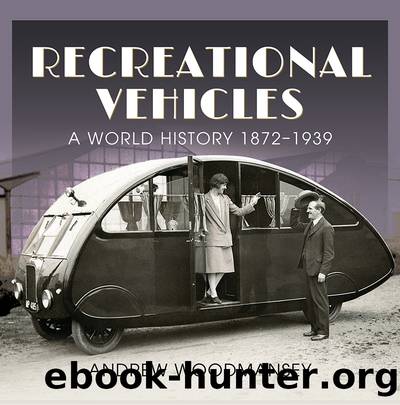Recreational Vehicles by Andrew Woodmansey;

Author:Andrew Woodmansey;
Language: eng
Format: epub
Tags: TRANSPORTATION / Automotive / Pictorial
Publisher: Casemate Publishers & Book Distributors, LLC
Published: 2021-10-08T00:00:00+00:00
As engines increased in power, chassis could be lengthened and weight increased. This led to the development of long-distance touring automobiles called touring limousines, first conceived in France by de Dietrich in 1904 (see pages 78-79). They were intended for use by wealthy travellers and offered far greater luxury than the camp car. In 1909, The Welch Motor Car Company of America produced a specially lengthened 80hp six-cylinder vehicle for actor Nat Goodwin to be used for touring purposes. It seated up to eight people and its rear seat could be converted to a transverse bed suspended on straps. It also included bath, refrigerator, crockery and numerous small cupboards and lockers. It weighed 3 tons and was said to âget over the ground splendidlyâ.
Pierce-Arrow followed Welch a year later with the Pierce-Arrow Touring Landau. The companyâs first landau was constructed for Pierce-Arrow president George Birge and shown at the 1910 Madison Avenue Motor Show in New York, arousing much interest. It had a 66hp engine and cost $8,250, a small fortune at the time. It included considerable luggage space on the roof and at the rear for long term touring, automatic folding steps and a sink supplied by a water tank under the chassis. Although the rear seat and back cushion could be arranged to form a bed, owners were generally expected to be able to afford hotel accommodation. The interior was made of tooled leather and a telephone could be installed for communication between the owner and chauffeur. It is thought that the vehicle was built only to order for a very small number of fortunate customers.
Another luxury limousine that explored the camping possibilities of the automobile appeared in 1911. In 1908, Thomas Coleman du Pont, a member of the Delaware-based family that founded the DuPont conglomerate, decided to build and finance a highway in Delaware to help the stateâs economy and increase tourism. Construction got underway in about 1911. As an engineer, he wanted to oversee the construction of the road, and, in the absence of any alternative accommodation in the area, du Pont commissioned a âcamping autoâ.
Download
This site does not store any files on its server. We only index and link to content provided by other sites. Please contact the content providers to delete copyright contents if any and email us, we'll remove relevant links or contents immediately.
| Buyers' Guides | Classic Cars |
| Customize | Driver's Education |
| Electric & Hybrid | Foreign |
| History | Industry |
| Insurance | Luxury |
| Motorcycles | Pictorial |
| Racing | Repair & Maintenance |
| Trucks & Vans |
Machine Learning at Scale with H2O by Gregory Keys | David Whiting(3791)
Never by Ken Follett(3613)
Urban Outlaw by Magnus Walker(3267)
OPNsense Beginner to Professional by Julio Cesar Bueno de Camargo(3206)
Sapiens and Homo Deus by Yuval Noah Harari(2905)
Will by Will Smith(2654)
A Short History of Nearly Everything by Bryson Bill(2540)
Hooked: A Dark, Contemporary Romance (Never After Series) by Emily McIntire(2440)
Rationality by Steven Pinker(2189)
Borders by unknow(2129)
Holy Bible (NIV) by Zondervan(2037)
The Becoming by Nora Roberts(1972)
The One Percenter Encyclopedia by Bill Hayes(1728)
Freedom by Sonny Barger(1724)
HBR's 10 Must Reads 2022 by Harvard Business Review(1716)
A Short History of War by Jeremy Black(1695)
Five Ways to Fall by K.A. Tucker(1648)
Girls Auto Clinic Glove Box Guide by Patrice Banks(1631)
Go Tell the Bees That I Am Gone by Diana Gabaldon(1612)
